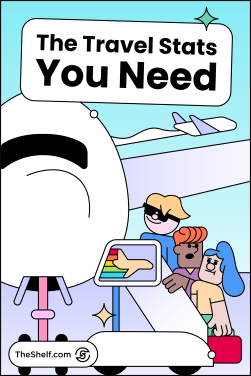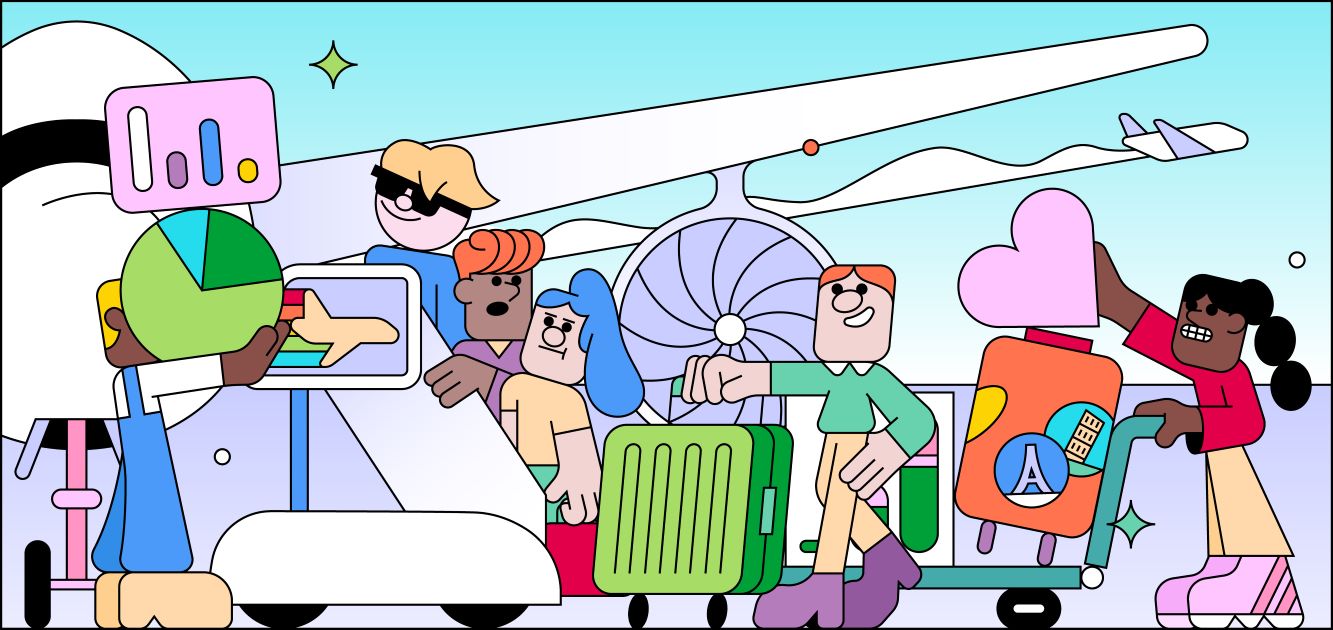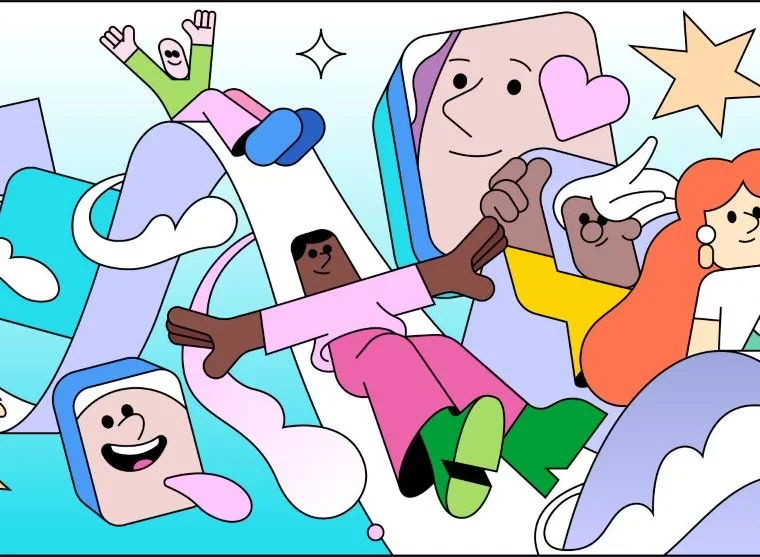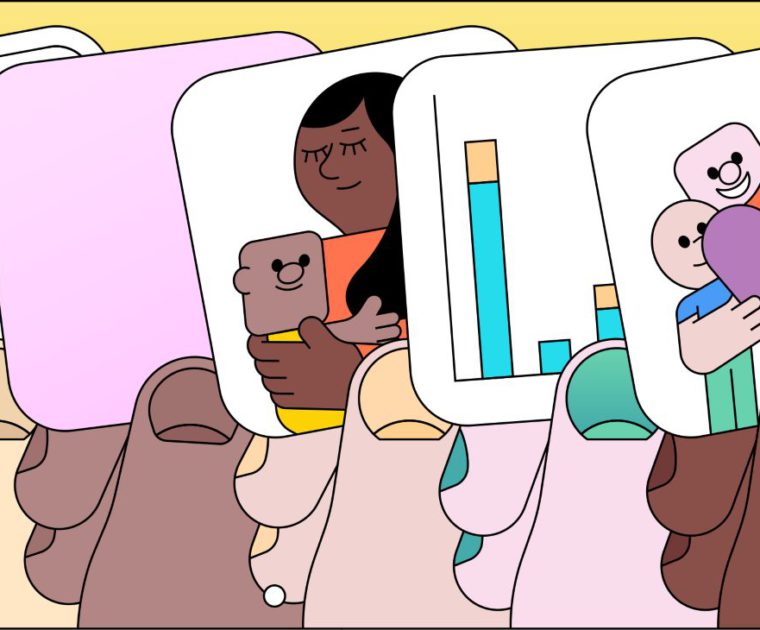Are you looking to run a travel marketing campaign this year? Well, you’re in luck. We’ve compiled all the essential travel stats you need to know to reach your goals and exceed expectations.
We’ll break down the travel trends by generation. That way, you can implement the best practices for marketing to different generations of travelers. Plus, we’ll go over the sustainable travel trends, how technology influences travel behavior, and all the other 2024 travel statistics marketers like you need to know.
So what are the latest travel stats of 2024? Let’s dive in.
Overall Travel Trends in 2024
The post-pandemic travel bug is still impacting travel trends in 2024. Travelers are eager to take a break from work and get out into the world. Here are some general travel stats you may find helpful in planning your upcoming travel marketing campaigns.
1. Most Americans plan to travel in 2024.
90 percent of Americans plan to take a trip this year. 85 percent plan to travel out of state. Most plan to travel with loved ones. 53 percent will travel with family and 41 percent with significant others.
2. 80 percent of Americans say travel is important for wellbeing.
Top motivators for travelers include beauty, relaxation, and family-friendly experiences. 37 percent say they are motivated to travel to be in beautiful surroundings. 33 percent travel for relaxation and well-being. And 30 percent are motivated by family fun.
3. The most common type of trip in 2024 will be to visit family and friends.
46 percent of American travel will consist of trips to visit loved ones. After that, the most common trip types are beach vacations (36 percent) and road trips (34 percent).

4. 2024 trip costs are rising an average 36 percent compared to last year.
Most travelers (93 percent) plan to spend at least some time budgeting, comparing costs, and searching for deals when planning upcoming travel. And 68 percent plan to spend a lot of time on those cost-cutting activities.
5. 96 percent of Americans expect inflation to impact their travel plans.
Nearly half (48 percent) plan to cut travel costs by traveling closer to home or during the off-season of their destination to cope with the squeeze of inflation. Another 44 percent plan to spend less on accommodations to account for inflation’s impact.
6. Nearly 8 in 10 Americans plan to travel by car.
78 percent of Americans plan to get to their vacation destinations by car, while 35 percent intend to fly. So it might be a good time to strategize that road trip campaign!
Gen Z Travel Preferences
You may be wondering: how do Gen Z and Millennials differ in their travel preferences? We had the same question. That’s why we broke down Gen Z travel, Millennial travel, and Boomer travel by the numbers, so you can hyper-target your next travel marketing campaign. Use these insights for marketing to Gen Z (born 1997-2012).
7. 84 percent of American Gen Z adults plan to take a trip this year.
That’s more than any other traveling demographic. Gen Z loves to travel. In fact, 75 percent have taken two or more trips in the last year.
8. Half of American Gen Z adults plan to travel internationally in 2024.
That’s right, 49 percent of Gen Z adults plan to leave the U.S. for leisure travel in the next 12 months. Again, that’s more than any other traveling demographic. If you’re looking to target travelers, especially international ones, in your next campaign, set your sights on a Gen Z audience.
9. 65 percent of Gen Z are expected to spend more on travel than last year.
Gen Z knows how to budget for travel and find the best deals. In fact, 38 percent spend a lot of time comparing pricing for upcoming travel destinations and activities to get the most bang for their buck.
10. The average Gen Z trip of 2024 costs $11,766.
That’s up 39 percent from last year. It’s no wonder 97 percent of Gen Z are concerned about rising costs affecting their travel plans.
11. Most Gen Z prioritize excitement over relaxation when traveling.
57 percent of Gen Z travel for excitement and exploration rather than downtime. They go for experiential value, immersive exploration, and authentic experiences. Gen Z is more likely to forgo the fancy all-inclusives in favor of budget-friendly options with more experiential value. If your travel marketing campaign is experience-based, Gen Z is a good target demo. Consider them for holiday travel and other experiential campaigns.
12. 73 percent of Gen Z consider local cuisine when selecting travel destinations.
And almost half (49 percent) follow food influencers whose content helps them make travel-related decisions.
13. 89 percent of Gen Z use TikTok to find travel destination inspo.
And more than half (53 percent) use multiple social media channels for leisure travel recommendations.
14. Italy and Japan are the most popular 2024 travel destinations for Gen Z.
This coincides with Gen Z’s tendency to go for cultural experiences over partying or relaxation destinations. Gen Z and their Millennial counterparts searched prices for travel destinations in Asia 50 percent more last year in 2023 than pre-pandemic.
Millennial Travel Habits
Millennials (born 1981-1996) are the second most likely generation to travel in 2024, they pack the most baggage, and they’re spending the least on average. Here’s how the travel stats shake out for 2024 Millennial travel.
15. 77 percent of Millennials plan to travel this year.
They’re the second-most likely to travel for leisure of any demographic in 2024. They trail only behind their younger Gen Z friends.
16. 3 in 10 Millennials expect to travel internationally in 2024.
29 percent of Millennials say they’ll travel internationally in the next 12 months. They’re still second to Gen Z in this category.
17. 72 percent of Millennials are expected to spend more on travel than last year.
And they’re careful about where and how they spend on travel. 34 percent of Millennials spend a lot of time comparing pricing of travel destinations and activities for upcoming trips, according to a study by Washington State University.
18. The average Millennial trip of 2024 costs $9,670.
This is the lowest average trip cost for generations of travelers. But Millennials have seen the highest percentage cost increase year-over-year. The 2024 average is up 48 percent from 2023.
19. Family-friendly options are important to most Millennial parents.
91 percent of Millennial parents prioritize family-friendly options when researching travel destinations.
20. Millennials are willing to pay more for comfort and convenience while traveling.
A large majority (83 percent) of Millennials want to feel cared for while traveling. 60 percent say the purpose of their vacations is to rest and recharge, compared to 52 percent who prioritize exploration and adventure.
21. Punta Cana and Rome are top destinations for Millennial parents.
Millennials are more likely to take quick weekend getaways. Punta Cana is the top destination for these brief excursions, especially for those with children under five. For those with older kids and teens, Rome tops the list and is likely to be the destination for longer trips.
Travel Trends for Consumers Over 60
Up next we’ve got Baby Boomers (born 1946-1964). Let’s dig into how they travel, how much they spend, and what they’re looking for in their 2024 trips.
22. 74 percent of Baby Boomers plan to travel in 2024.
While most Baby Boomers intend to take a trip this year, only 21 percent plan to travel internationally. That makes them the least likely generation to travel outside the country.
23. The average Baby Boomer trip of 2024 cost $10,680.
That’s up 36 percent year-over-year. And Boomers don’t spend a lot of time planning where that spend will go. They spend the least amount of time searching for deals on travel when compared to other generations. Only 19 percent spend a lot of time planning their trip budgets.
24. Most Baby Boomers use online services to book their travel.
84 percent of Boomers book their travel online. They’re most likely to read reviews about travel destinations on Facebook and TripAdvisor.
25. Baby Boomers account for 20 percent of all travel spending.
Boomers are willing to spend more on what they value. Think nonstop flights, travel comforts, and luxury accommodations.
26. Boomers favor activity-focused travel packages.
Boomers are most likely to go for travel packages. They take little planning, often feature all-inclusive options, and allow for immersive activities with minimal research.
27. Top travel destinations for Boomers include Florida, California, and Las Vegas.
Because Boomers are most likely to travel domestically, it makes sense these are the hot spots. For those who do travel internationally, Europe features the most desired destinations. Top international spots include Italy, Spain, and Great Britain.
Travel Statistics on Sustainability
Travel is going green as more and more Americans prioritize sustainable practices at home and on vacation. Let’s see how the 2024 travel stats shake out.
28. 75 percent of Americans prioritize sustainability while traveling.
This means considering greener modes of transportation, eco-friendly lodging, and being conscious of their impact on local destinations.
29. Parents with children under 18 care more about sustainable travel.
59 percent of parents with kids under 18 say they prioritize sustainability when planning travel. This is compared to 41 percent of other Americans. This could be due to the consciousness-raising of Gen Alpha on their parents, but the data is unclear.
30. Traveling sustainably doesn’t mean going off the grid.
56 percent say they don’t believe it’s important to go to rustic locations without access to technology to travel sustainably. Boomers are the generation to agree with this most, with 65 percent echoing the sentiment.
31. More than half of Gen Z is willing to pay more for environmentally responsible travel.
Gen Z prioritizes eco-friendly destinations that use renewable energy and minimize waste. And they’re willing to put their money where their mouth is. 54 percent of Gen Z will pay more for more sustainable travel services. Gen Z is considered to be the most environmentally conscious generation of travelers.
Impact of Technology on Travel
How is technology impacting travel behavior, you ask? Let’s break it down.
32. Gen Z is most likely to use AI when traveling or planning travel.
75 percent of Gen Z use AI-powered tools to help plan their travel. That’s the most of any generation. And a majority (73 percent) of Gen Z believe that AI has a net positive effect on their travel planning. 41 percent report using AI to plan trip itineraries. And 43 percent use AI for help while traveling. But Gen Z isn’t without concerns. More than half (56 percent) are wary of using AI-powered travel tools due to privacy concerns.
33. Boomers are least likely to use AI when traveling or planning travel.
Only 28 percent of Baby Boomers have used AI-powered tools to plan travel or for help while traveling. However, 50 percent of Boomers believe the overall impact of AI on travel is more positive than negative.
34. Men are more likely to use AI for travel than women.
55 percent of American men have used AI when traveling or planning travel, compared to 46 percent of women.
That’s a Wrap on 2024 Travel Stats
So there you have it. All the 2024 travel statistics you need to know to create travel marketing campaigns that will wow vacationers from every generation. We hope this roundup gave you some insight into travel trends and the impacts of technology and sustainability on the current travel market.
Want help creating your next travel marketing campaign? There are more travel statistics where these came from! Our expert team can help you craft the perfect campaign to crush your goals using all the latest industry trends and insights. Schedule a strategy call with us today to get started.







